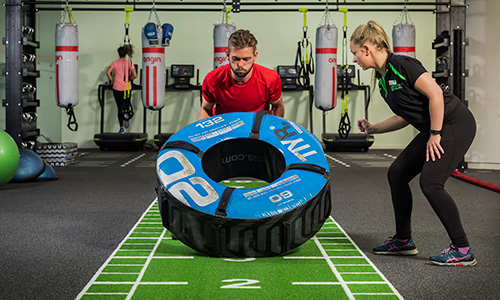Why is there astroturf in my gym? Functional training explained
- Overview
- Full article
Functional training is a type of training that uses real-life movements and activities to help you thrive outside the gym. This type of training isn’t new. It’s how our ancestors kept fit before the invention of the gym: by using their bodies as nature intended.
Now functional training has a name, and more people are waking up to the improvements it can bring to all aspects of life; from keeping up with the kids in the park to getting the most out of a skiing holiday, from carrying the shopping home to recovering from an injury.
Functional training can also help athletes looking to improve specific repetitive motions: think golfers or tennis players who want to work on their swing. It’s also helpful for those needing to build all-around fitness: there’s no point in a weightlifter deadlifting 400+ pounds if they can’t touch their toes.
So why astroturf?

We’ve installed this flooring in our functional training areas to complement the real-life movements found in this method of training: squats, pulling, pushing and rotating. Astroturf provides a realistic feel and is more comfortable. It absorbs shock, adds traction and helps with resistance. It also replicates the surface found in many sports.
You’re also likely to find floor mats, medicine balls, free weights, battle ropes, kettlebells and suspension trainers in the functional training area. Correctly used, this equipment is designed to help you build strength, flexibility, balance and posture in everyday life. It will also help you reduce your risk of injury and boost your performance in other sports.
What gym equipment is used in functional training?
Medicine balls are weighted balls that help improve your core strength, flexibility, range of motion and coordination. A key tool of functional training for a long time: even the Greek physician Hippocrates is said to have stuffed animal skins for patients to throw around for medicinal purposes. Ask your personal trainer about a exercises you can do with a medicine ball, including a squat with an overhead lift.
Free weights are a great way to train using complete movement patterns such as squats, lunges, pushing and pulling, twisting and bending. Rather than machines, free weights allow you to use large body movements that mimic everyday activities. Free weights also force your body to support itself, which is much more functional. Ask your Personal Trainer about Dumb Bell Squats.
Battle ropes integrate cardiovascular training with resistance training. These weighted, flexible ropes can help build strength in your arms, back, chest, legs, and core. Ask your personal trainer about double rope slams.
Kettlebells are weights that look like cannonballs with handles. They promise to raise your heart rate and improve strength, cardio, stability, power, endurance and balance by recruiting muscles throughout the body, unlike traditional weight-training which isolates muscles. Ask your personal trainer about kettlebell swings, and try this kettle strength workout.
Suspension trainers, or cable pulleys, are the ultimate functional training tool, enabling you to work out your whole body in one session. You train by moving cables around, against resistance. You can pull the cables in any direction and employ various cable attachments for maximum creativity. Ask your Personal Trainer about standing cable rows.
Last updated Friday 5 April 2019
First published on Friday 5 April 2019

